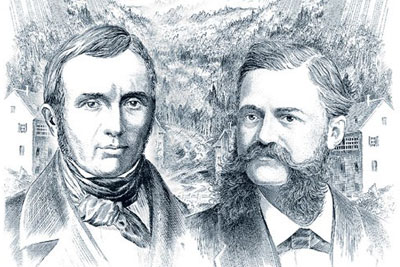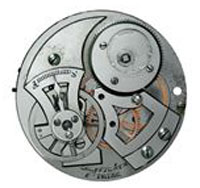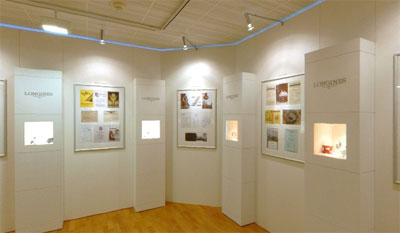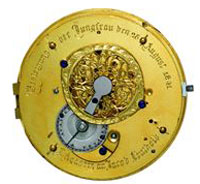|
 The Swiss watch company The Swiss watch company started operating since 1832, when Auguste Agassiz started his own way in the watchmaking industry in St Imier, Switzerland. The experience in watchmaking industry during about two centuries demonstrates the company's strong devotion to tradition, elegance and sporting world: it has generations of working as an official timekeeper at world championships and as a partner of international sports federations. The Longines company is a member of the Swatch Group S.A., the world's leading manufacturer of watches and associated products. Having the faultless reputation of an exquisite watchmaker, this brand, whose emblem is the winged hourglass,is now represented in 130 countries around the world. started operating since 1832, when Auguste Agassiz started his own way in the watchmaking industry in St Imier, Switzerland. The experience in watchmaking industry during about two centuries demonstrates the company's strong devotion to tradition, elegance and sporting world: it has generations of working as an official timekeeper at world championships and as a partner of international sports federations. The Longines company is a member of the Swatch Group S.A., the world's leading manufacturer of watches and associated products. Having the faultless reputation of an exquisite watchmaker, this brand, whose emblem is the winged hourglass,is now represented in 130 countries around the world.
In 1850s, the head of the company having won the excellent reputation, was Ernest Francillon, a nephew of Auguste Agassiz, who started searching different ways to improve traditional methods of local watchmaking. His idea was to join various making procedures within a one factory and to use mechanical production methods for final watch construction. To put his projects into life, he bought two adjoining plots of land located on the right bank of the river Suze in the Saint-Immier valley in 1866. This area of land was called Les Longines. To develop machines, he needed to improve the watchmaking process, and, because of it, Ernest began working with his young relative, an engineer named Jacques David. In 1870s, the industrial approach, having been chosen by Ernest, was very successful, and the factory continued to grow until the first third of the 20th century. In 1922, more than 1,100 employees worked at the factory, and Longines watches were sold around the world.
 For the technical research, For the technical research,  the company received many awards and distinctions. The brand with the winged hourglass has been called “Leading Prize Winner” at several international exhibitions including the Barcelona Exhibition of 1929 and received no fewer than 10 Grands Prix. The winged hourglass logo together with the Longines name form the oldest brand, whose symbols are in use today and are registered with the World Intellectual Property Organisation. They have remained unchangeable since 1867, when they were accepted as a sign of quality to fight against the piracy product growth, producers of which tried to derive advantage from the company's excellent reputation. the company received many awards and distinctions. The brand with the winged hourglass has been called “Leading Prize Winner” at several international exhibitions including the Barcelona Exhibition of 1929 and received no fewer than 10 Grands Prix. The winged hourglass logo together with the Longines name form the oldest brand, whose symbols are in use today and are registered with the World Intellectual Property Organisation. They have remained unchangeable since 1867, when they were accepted as a sign of quality to fight against the piracy product growth, producers of which tried to derive advantage from the company's excellent reputation.
Thanks to accumulated experience, having been gained by the company in the area of developing watches, Longines bears a special relations to the world of sports. It invented several chronometers for the precise timing of sports events, such as the “broken wire” automatic timing system used at the Swiss Federal Gymnastics meeting in 1912, the Photogines, the first mechanism to link timing with a photo finish, in 1952, and the Contifort in 1960, which was the first system to combine timing with a moving image. These inventions enabled Longines to provide the timing for a large number of universal importance events and set a decent place in the chronicles of sport. Its supreme mastery and highly-precision technology enabled the company to introduce its timing systems into the world of Formula 1, and developed a prestigious partnership with the famous Italian car company, Ferrari.
Thanks to a long history of the partnership with the world of sports, today the company provides the timing for equestrianism, gymnastics, short-track speed skating, archery, tennis and skiing competitions. All of these sports demonstrate the brand’s main qualities of precision and elegance.
To embody its values of tradition, elegance and performance, Longines has appointed several Ambassadors of Elegance. These are celebrities whose personalities correspond to the brand’s image, such as the famous tennis couple Andre Agassi and Stefanie Graf, the Indian actress Aishwarya Rai Bachchan, the Chinese star Aaron Kwok Fu Shing, the Russian actor Oleg Menshikov and the Lithuanian actress Ingeborga Dapkunaite. Other Longines Ambassadors of Elegance include the models Denise Keller and Chi Ling Lin, and the German actor Peter Lohmeyer.
But th e company does e company does not stint itself in the timing for sporting events. Since 1919, it has been the official supplier to the FAI, the World Air Sports Federation, and has provided the aeronautical world with the timing equipment required to verify several world records. Among them there was the historic human and technical achievement of the American pilot, Charles Lindbergh, who, in 1927, made the first non-stop solo crossing of the North Atlantic in his vessel named “Spirit of St Louis”. Longines instruments have accompanied many explorers on journeys around the planet and have supported the pioneers of the sky. not stint itself in the timing for sporting events. Since 1919, it has been the official supplier to the FAI, the World Air Sports Federation, and has provided the aeronautical world with the timing equipment required to verify several world records. Among them there was the historic human and technical achievement of the American pilot, Charles Lindbergh, who, in 1927, made the first non-stop solo crossing of the North Atlantic in his vessel named “Spirit of St Louis”. Longines instruments have accompanied many explorers on journeys around the planet and have supported the pioneers of the sky.
Today, Longines creates timepieces that are adapted to the difficulties of the modern world, and at the same time the company follows its principal values. The vivid example of watchmaking traditions of the winged-hourglass brand is models in the Longines Master Collection, the Longines Evidenza, Longines Spirit and the Heritage Collection (Flagship Heritage, Longines Clous de Paris, Conquest Heritage, or Les Elégantes de Longines). Its devotion to elegance conception is expressed in the Longines Dolce Vita, Longines BelleArti (contemporary elegance) and La Grande Classique de Longines (classic elegance) collections. Finally, all of the company's sporting experience is in the performance of models such as the HydroConquest, Longines Conquest, GrandVitesse and Longines Admiral. The Longines Sport Legends (The Longines Weems Second-Setting Watch, the Lindbergh Hour Angle Watch, the Longines Legend Diver and the Longines Istituto Idrografico R. Marina Watch) all pay tribute to the famous instruments that have been invented by the brand with the winged hourglass.
|
